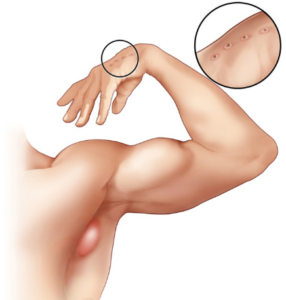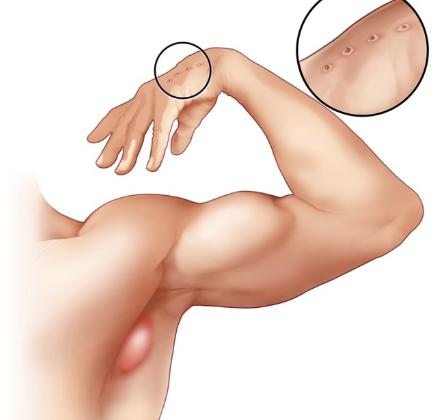Lymph nodes have been called the “upper management” of the immune system by journalist Matt Richtel. Some of the more impressive aspects of the immune system, such as the ability to recognize pathogens that may have been encountered years earlier, occur in the lymph nodes.
Lymph nodes are scattered throughout the body. Some are as small as a poppy seed. Others are much larger. Tonsils are lymph nodes in the throat. The spleen is a specialized structure of the lymph system that is similar to a lymph node.
The lymph system circulates a fluid called lymph between all the cells in the body. Scientists used to think that the brain was isolated from the lymph system, but in 2017 researchers discovered that the brain drains lymphatic fluid into the lymph system. This means that the immune system has contact with antigens that may be drained from the brain. How the immune system and the brain interrelate is a productive area of research that is leading to developments in understanding of a variety of psychiatric conditions.
Lymph fluid travels very slowly through the body. Unlike blood, there is no pump circulating the fluid. The total circulation of lymph fluid is only a little over a gallon per day. Nonetheless, a person would die quickly without this vital flow removing debris from cells and informing the immune system of everything that is going on in the body. Lymph fluid consists of:
- macrophages, which remove debris
- lymphocytes, a white blood cell
- some red blood cells
- chyle, a fatty fluid produced by the small intestine
- other specialized immune cells.
The lymph nodes are continually exposed to all of the proteins circulating in the body, including proteins that are shed from the surfaces of pathogens. As these proteins pass through the lymph nodes, they encounter a variety of T cells with antigen receptors for previously encountered pathogens.
If prior experience with an antigen was long ago or did not create a strong immune response, there may only be a few T cells in the lymph system that match that antigen. Age and immune suppression may also reduce the number of T cells produced. Nonetheless, a few T cells with the correct antigen receptor can still be effective. If the antigen encounters one of those T cells, the T cell activates and sets off a response from the adaptive immune system.
This immune response may cause lymph nodes to swell (lymphadenitis). The immune response may be to something that would otherwise be harmless- an in an allergic reaction. The immune response may be to a harmful pathogen. T-cells also attack cancer cells, and this function of the immune system to fight cancer is being used in new treatments such as CAR-T immunotherapy.
There can be other causes of lymph node swelling such as a blockage or cancer of the lymph system itself. Furthermore, because waste is continually flowing through the lymph nodes, they are susceptible to metastasized cancer from other areas of the body.
A swollen lymph node near the skin may cause redness and pain, and swollen lymph nodes in the head and neck may cause pain and even difficulty breathing. However, swollen lymph nodes in other locations may have more diverse symptoms that are difficult to pinpoint.
If the swollen lymph node is in response to an infection, swelling will generally go down within a few weeks of the infection being resolved. In some cases chronic lymph node swelling results.
Whether lymph node swelling and tenderness occurs with a Bartonella species infections depends on a lot of factors. Cat scratch disease, an acute Bartonella henselae infection most frequently seen in children, is usually characterized by lymph node swelling near the site of the scratch.

However, other Bartonella species infections may have no lymph node swelling at all. One study of 913 patients with Bartonella henselae infection found that patients with musculoskeletal pain were less likely to have lymph node swelling than patients with other symptoms.
While lymph node swelling is not diagnostic of vector-borne disease, it can help point to an infectious cause in hard-to-diagnose cases. For example, a child with bone inflammation (osteomyelitis) caused by Bartonella henselae also had pancreatic duodenal lymphadenitis. In another case, a woman had a retinal vessel occlusion, erythema on her legs, and an enlarged lymph node. These additional symptoms helped physicians find the infectious cause of her vision loss.
Conclusion
Lymph nodes have contact with every part of the body via the circulation of lymph fluid. They send very specific signals to the body in terms of antigen response and these signals can be measured through serology blood tests. However other signals, such as swelling and pain, are very difficult to interpret because they could have a number of causes originating from any body part. As researchers develop more understanding of the lymph system, care providers will have more tools to diagnose and treat illness.
References
Richtel, M. (2019). What makes your immune system an elegant defense? [Podcast]. The People’s Pharmacy, show 1170. Available at: https://www.peoplespharmacy.com/articles/show-1170-what-makes-your-immune-system-an-elegant-defense/
Maman, E. et al. (2007). Musculoskeletal manifestations of cat scratch disease. Clinical Infectious Diseases, 45, 1535-1540. https://doi.org/10.1086/523587 https://academic.oup.com/cid/article/45/12/1535/302797?fbclid=IwAR2vMLyqMIgbTUvZO-uczguDZ2PES5lZG46XLlqJ5AfldYZAcml47vcDL-Y
Stepanić, M. et al. (2019). First isolation and genotyping of Bartonella henselae from a cat living with a patient with cat scratch disease in Southeats Europe. BMC Infectious Diseases, 19(1), 299. doi:10.1186/s12879-019-39290z https://www.ncbi.nlm.nih.gov/pubmed/30940084
Woo, M. et al. (2018). A case of retinal vessel occlusion caused by Bartonella infection. Journal of Korean Medical Science, 33(47), e297. doi:10.3346/jkms.2018.33.e297 https://www.ncbi.nlm.nih.gov/pmc/articles/PMC6236082/
National Institutes of Health. (2017, October 17). Brain cleaning system uses lymphatic vessels. NIH Research Matters. Available at: https://www.nih.gov/news-events/nih-research-matters/brain-cleaning-system-uses-lymphatic-vessels


